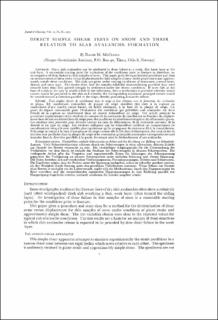| dc.contributor.author | McClung, David | |
| dc.date.accessioned | 2023-10-25T17:49:27Z | |
| dc.date.available | 2023-10-25T17:49:27Z | |
| dc.date.issued | 1977 | |
| dc.identifier.issn | 0022-1430 | |
| dc.identifier.uri | https://hdl.handle.net/11250/3098799 | |
| dc.description.abstract | Many slab avalanches can be attributed to shear failure in a weak, thin basal layer at the slab base. A reasonable starting point for evaluation of the conditions prior to fracture is, therefore, an investigation of shear failure in thin samples of snow. This paper gives the experimental procedure and data on measurements of shear stress versus displacement for thin samples of snow under plane strain and approximately simple shear conditions. The data are given under varying conditions of strain-rate, normal stress, density and snow type. The results show that the samples exhibited strain-softening provided they were sheared faster than they gained strength by settlement under the chosen conditions. If snow fails at the base of a slab in the way in which it fails in the laboratory, then a mechanism is provided whereby tensile stresses would be produced in the slab and whereby the corresponding maximum principal stresses would be rotated toward a direction parallel to the slope, thereby promoting avalanche release. | en_US |
| dc.language.iso | eng | en_US |
| dc.publisher | Cambridge University Press | en_US |
| dc.subject | Avalanche-RnD | en_US |
| dc.subject | Snøskred-FoU | en_US |
| dc.title | Direct Simple Shear Tests on Snow and their Relation to Slab Avalanche Formation | en_US |
| dc.type | Journal article | en_US |
| dc.rights.holder | International Glaciological Society | en_US |
| dc.source.pagenumber | 101-109 | en_US |
| dc.source.volume | 19 | en_US |
| dc.source.journal | Journal of Glaciology | en_US |
| dc.source.issue | 81 | en_US |
| dc.identifier.doi | 10.3189/S0022143000215578 | |
